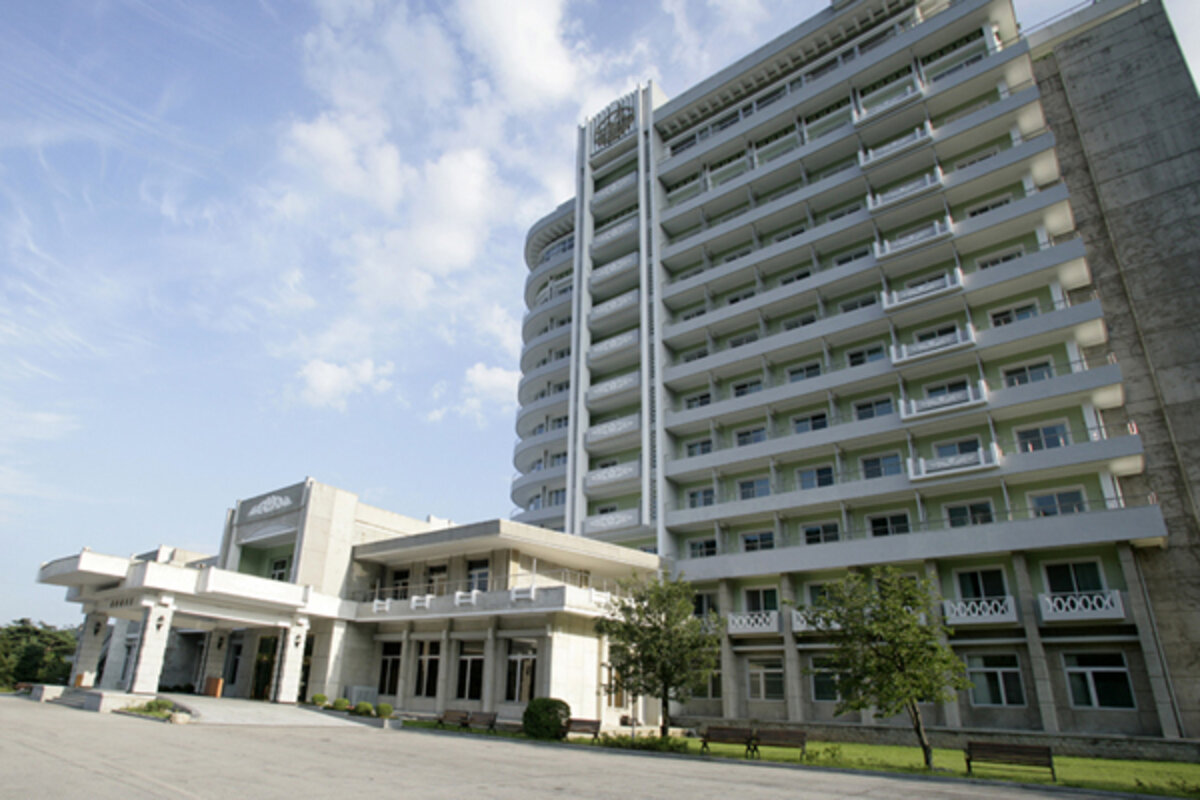North Korea takes over Mt. Kumgang tourist area, further dimming Sunshine legacy
Loading...
| Seoul, South Korea
Few natural wonders are more distinctive than the Mount Kumgang region of several thousand granitic crags looming inside North Korea beyond the demilitarized zone that has divided the Korean peninsula since the Korean War.
For the late Chung Ju-yung, founder of the Hyundai industrial empire, Kumgang, which means Diamond Mountain, was a dream that beckoned long after he ran away from the nearby village of Asan to seek his fortune in Seoul during the Japanese colonial era. One of his proudest achievements, three years before he died in March 2001, was to open tourism to Kumgang by boat to a small port on the east coast.
In recent years, however, Kumgang has come to epitomize the frustrations of entrée into the North. Hyundai Asan, the company that Mr. Chung founded to make deals with North Korea, has invested well over $1.5 billion in Kumgang for a hotel, hot springs, a shopping mall, a road, and other facilities. But the payoff has been tragedy – and, most recently, North Korea’s announcement that it’s taking over all Asan’s operations at Kumgang.
“It’s a political campaign by North Korea to change South Korean policy,” says Yun Dae-gyu, vice president of Kyungnam University here. He sees little prospect of reopening tours to Kumgang, banned by South Korea’s President Lee Myung-bak after a North Korean guard shot and killed a South Korean tourist who had wandered outside the tourist zone nearly three years ago.
“This government claims they have to apologize, and they are not going to do that,” says Mr. Yun. At the same time, he doubts if North Korea will succeed in luring many tourists from China, as North Korean authorities say they plan to do.
In fact, if there is any reason to think the North Koreans may try to make amends with the South on Kumgang it's because of the difficulty they're having in drumming up interest in China.
South Korean officials meanwhile are adamant: “We demand North Korea take responsibility for shooting our tourist,” says Lee Jong-joo, a spokeswoman at the Unification Ministry, citing North Korea’s agreement with South Korea as guaranteeing Hyundai Asan’s right to the facilities. “North Korea does not respond.”
The overriding message is that of frustration in reaching any permanent understanding with North Korea on anything from business deals to doing away with its nuclear program.
An agreement between the US and North Korea, signed at Geneva in 1994 for North Korea to abandon the nuclear program in exchange for twin light-water nuclear energy reactors, broke apart eight years later with the discovery of a separate, secret uranium-enrichment program. North Korea also has not lived up to agreements reached in six-party talks in 2007.
Until the killing of the tourist, however, Hyundai Asan was still bringing South Korean and foreign tourists daily to Kumgang. The influx of tourists seemed to prove the success of the “sunshine” policy that the late Kim Dae-jung, president of South Korea from 1998 to 2003, had propounded when he flew to Pyongyang in June 2000 to meet North Korean leader Kim Jong-il for the first inter-Korean summit.
The downward spiral
The dream turned tragic when Chung Ju-yung’s fifth son, Chung Mong-hun, the chairman of Hyundai Asan, jumped to his death from Hyundai headquarters in August 2003 amid investigation into the channeling of hundreds of millions of dollars through Hyundai Asan to North Korea to get Kim Jong-il to agree to the summit.
North-South relations by that time were on a downward spiral after the conservative President Lee, elected in December 2007, cut off donations of rice and fertilizer that Kim Dae-jung and his successor, Roh Moo-hyun, had showered on the North for a decade.
The standoff over the death of the tourist assumed a much broader significance as Mr. Lee demanded the North give up its nuclear program as a prerequisite for aid. Now, the abrogation of North Korea’s agreement with Hyundai Asan on Kumgang endangers occasional “reunions” of divided families, agreed on at the June 2000 summit and held at Kumgang.
Paik Hak-soon, a veteran analyst of North Korea at the Sejong Institute here, says Kim Jong-il did apologize for the shooting when he received Chung Mong-hun’s widow, Hyun Jeong-eun, now in charge of Hyundai Asan, in Pyongyang in August 2009. “South Korea never accepted this kind of apology,” says Mr. Paik. Lately, he adds, Ms. Hyun has been asking “why South Korea is not moving at all.”
Still, the outlook is not entirely bleak. A Hyundai Asan official blames the standoff on “the hard-line stance” of both sides. “In the near future, we are trying to resume our business,” he says. “It will take a little time,” but “we are prepared for any situation.”




